Business Research: Mobile Banking and Customer Satisfaction
VerifiedAdded on 2021/06/16
|17
|4049
|390
Report
AI Summary
This business research report investigates the impact of mobile banking on customer retention and satisfaction, examining its role in enhancing business performance. The project's objectives include evaluating the influence of mobile banking on customer retention, satisfaction, and business growth, as well as assessing the associated risks. The report provides a literature review covering the current impact of mobile banking, customer satisfaction, and security threats. It discusses the increasing adoption of mobile banking, particularly in countries like India and China, and its effect on financial transactions. The report also highlights the importance of customer satisfaction, security measures, and the need for banks to adapt to technological advancements. The study concludes with recommendations for minimizing risks and improving the quality of mobile banking services. References and appendices are included to support the findings and provide additional context.
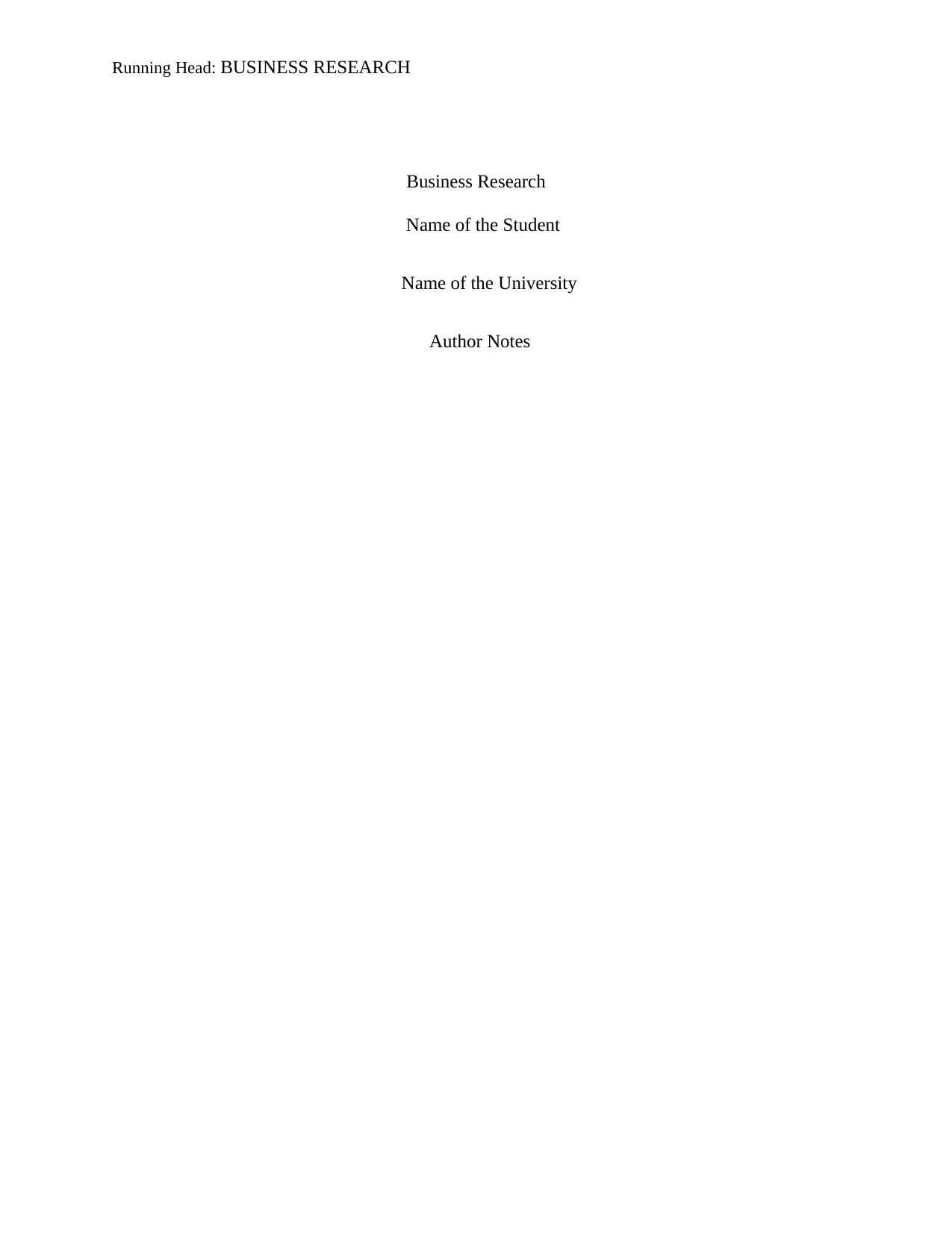
Running Head: BUSINESS RESEARCH
Business Research
Name of the Student
Name of the University
Author Notes
Business Research
Name of the Student
Name of the University
Author Notes
Paraphrase This Document
Need a fresh take? Get an instant paraphrase of this document with our AI Paraphraser
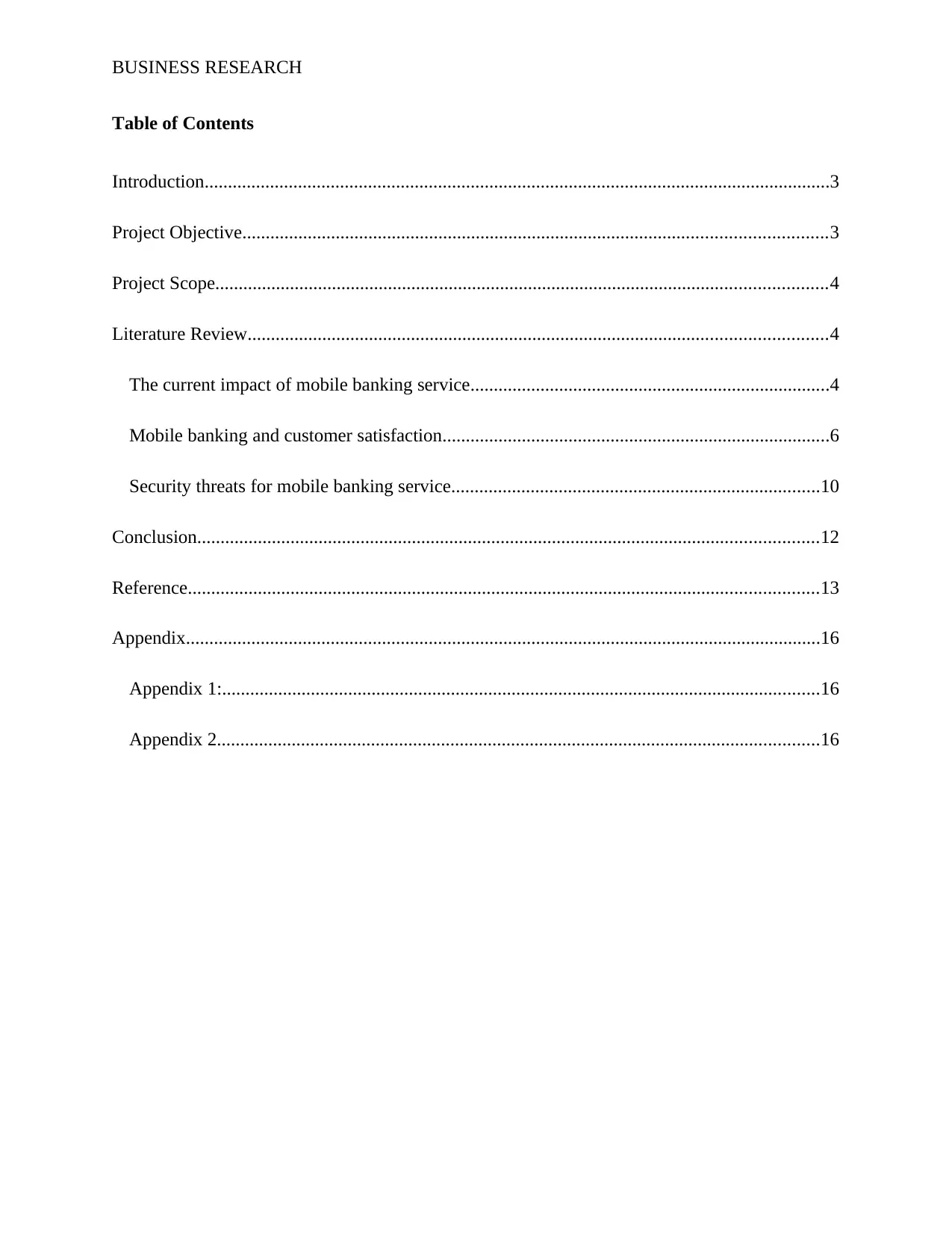
BUSINESS RESEARCH
Table of Contents
Introduction......................................................................................................................................3
Project Objective.............................................................................................................................3
Project Scope...................................................................................................................................4
Literature Review............................................................................................................................4
The current impact of mobile banking service.............................................................................4
Mobile banking and customer satisfaction...................................................................................6
Security threats for mobile banking service...............................................................................10
Conclusion.....................................................................................................................................12
Reference.......................................................................................................................................13
Appendix........................................................................................................................................16
Appendix 1:................................................................................................................................16
Appendix 2.................................................................................................................................16
Table of Contents
Introduction......................................................................................................................................3
Project Objective.............................................................................................................................3
Project Scope...................................................................................................................................4
Literature Review............................................................................................................................4
The current impact of mobile banking service.............................................................................4
Mobile banking and customer satisfaction...................................................................................6
Security threats for mobile banking service...............................................................................10
Conclusion.....................................................................................................................................12
Reference.......................................................................................................................................13
Appendix........................................................................................................................................16
Appendix 1:................................................................................................................................16
Appendix 2.................................................................................................................................16
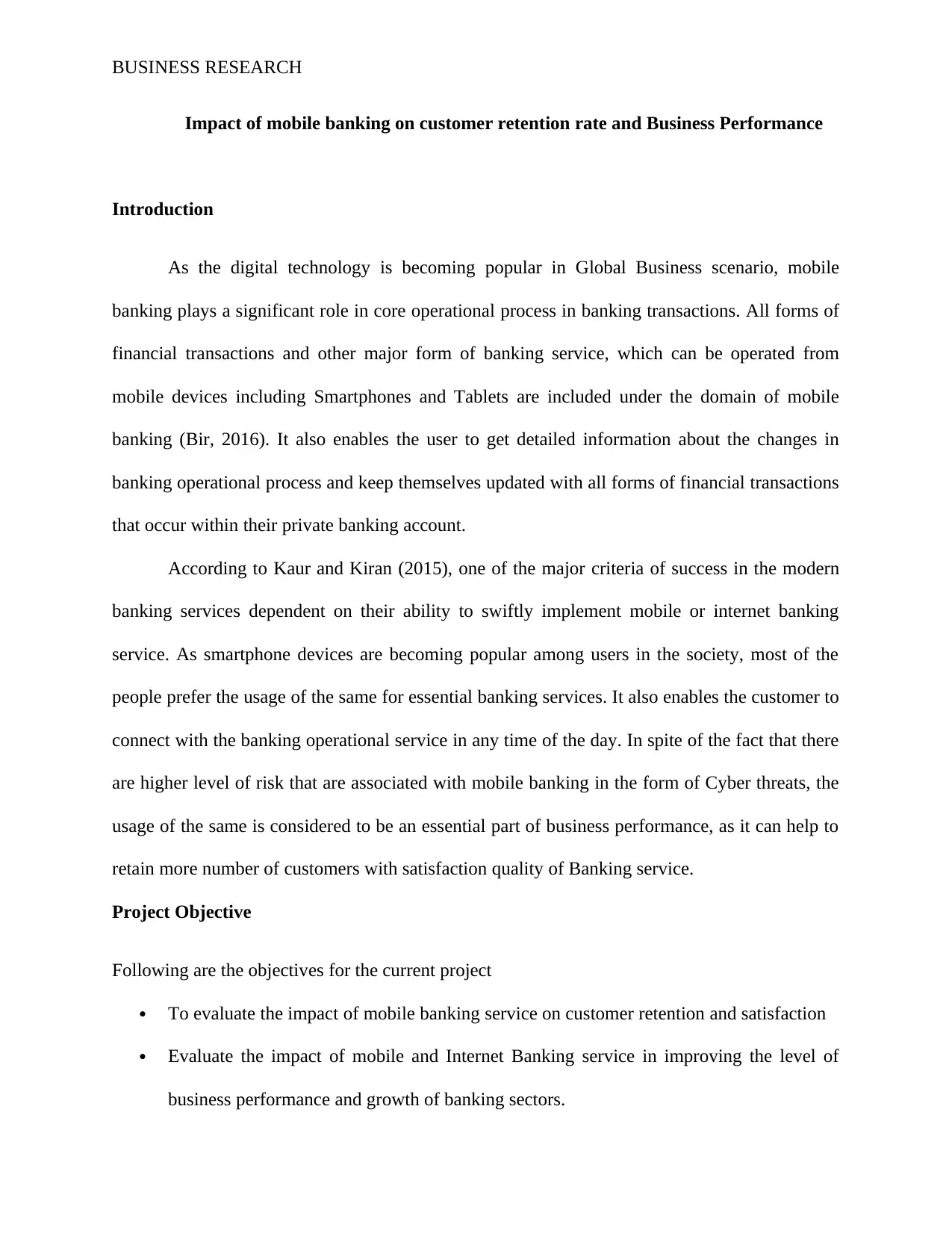
BUSINESS RESEARCH
Impact of mobile banking on customer retention rate and Business Performance
Introduction
As the digital technology is becoming popular in Global Business scenario, mobile
banking plays a significant role in core operational process in banking transactions. All forms of
financial transactions and other major form of banking service, which can be operated from
mobile devices including Smartphones and Tablets are included under the domain of mobile
banking (Bir, 2016). It also enables the user to get detailed information about the changes in
banking operational process and keep themselves updated with all forms of financial transactions
that occur within their private banking account.
According to Kaur and Kiran (2015), one of the major criteria of success in the modern
banking services dependent on their ability to swiftly implement mobile or internet banking
service. As smartphone devices are becoming popular among users in the society, most of the
people prefer the usage of the same for essential banking services. It also enables the customer to
connect with the banking operational service in any time of the day. In spite of the fact that there
are higher level of risk that are associated with mobile banking in the form of Cyber threats, the
usage of the same is considered to be an essential part of business performance, as it can help to
retain more number of customers with satisfaction quality of Banking service.
Project Objective
Following are the objectives for the current project
To evaluate the impact of mobile banking service on customer retention and satisfaction
Evaluate the impact of mobile and Internet Banking service in improving the level of
business performance and growth of banking sectors.
Impact of mobile banking on customer retention rate and Business Performance
Introduction
As the digital technology is becoming popular in Global Business scenario, mobile
banking plays a significant role in core operational process in banking transactions. All forms of
financial transactions and other major form of banking service, which can be operated from
mobile devices including Smartphones and Tablets are included under the domain of mobile
banking (Bir, 2016). It also enables the user to get detailed information about the changes in
banking operational process and keep themselves updated with all forms of financial transactions
that occur within their private banking account.
According to Kaur and Kiran (2015), one of the major criteria of success in the modern
banking services dependent on their ability to swiftly implement mobile or internet banking
service. As smartphone devices are becoming popular among users in the society, most of the
people prefer the usage of the same for essential banking services. It also enables the customer to
connect with the banking operational service in any time of the day. In spite of the fact that there
are higher level of risk that are associated with mobile banking in the form of Cyber threats, the
usage of the same is considered to be an essential part of business performance, as it can help to
retain more number of customers with satisfaction quality of Banking service.
Project Objective
Following are the objectives for the current project
To evaluate the impact of mobile banking service on customer retention and satisfaction
Evaluate the impact of mobile and Internet Banking service in improving the level of
business performance and growth of banking sectors.
⊘ This is a preview!⊘
Do you want full access?
Subscribe today to unlock all pages.

Trusted by 1+ million students worldwide
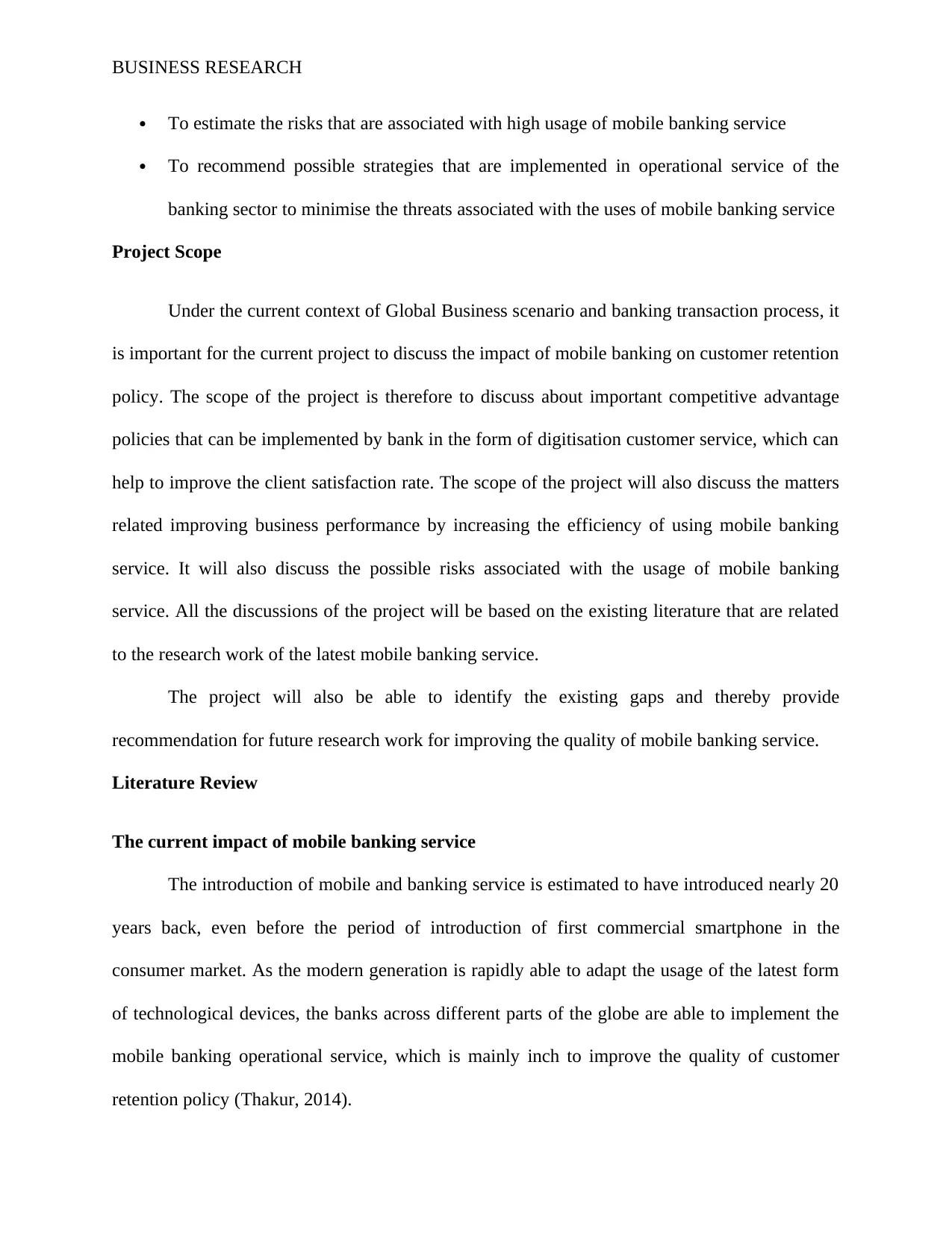
BUSINESS RESEARCH
To estimate the risks that are associated with high usage of mobile banking service
To recommend possible strategies that are implemented in operational service of the
banking sector to minimise the threats associated with the uses of mobile banking service
Project Scope
Under the current context of Global Business scenario and banking transaction process, it
is important for the current project to discuss the impact of mobile banking on customer retention
policy. The scope of the project is therefore to discuss about important competitive advantage
policies that can be implemented by bank in the form of digitisation customer service, which can
help to improve the client satisfaction rate. The scope of the project will also discuss the matters
related improving business performance by increasing the efficiency of using mobile banking
service. It will also discuss the possible risks associated with the usage of mobile banking
service. All the discussions of the project will be based on the existing literature that are related
to the research work of the latest mobile banking service.
The project will also be able to identify the existing gaps and thereby provide
recommendation for future research work for improving the quality of mobile banking service.
Literature Review
The current impact of mobile banking service
The introduction of mobile and banking service is estimated to have introduced nearly 20
years back, even before the period of introduction of first commercial smartphone in the
consumer market. As the modern generation is rapidly able to adapt the usage of the latest form
of technological devices, the banks across different parts of the globe are able to implement the
mobile banking operational service, which is mainly inch to improve the quality of customer
retention policy (Thakur, 2014).
To estimate the risks that are associated with high usage of mobile banking service
To recommend possible strategies that are implemented in operational service of the
banking sector to minimise the threats associated with the uses of mobile banking service
Project Scope
Under the current context of Global Business scenario and banking transaction process, it
is important for the current project to discuss the impact of mobile banking on customer retention
policy. The scope of the project is therefore to discuss about important competitive advantage
policies that can be implemented by bank in the form of digitisation customer service, which can
help to improve the client satisfaction rate. The scope of the project will also discuss the matters
related improving business performance by increasing the efficiency of using mobile banking
service. It will also discuss the possible risks associated with the usage of mobile banking
service. All the discussions of the project will be based on the existing literature that are related
to the research work of the latest mobile banking service.
The project will also be able to identify the existing gaps and thereby provide
recommendation for future research work for improving the quality of mobile banking service.
Literature Review
The current impact of mobile banking service
The introduction of mobile and banking service is estimated to have introduced nearly 20
years back, even before the period of introduction of first commercial smartphone in the
consumer market. As the modern generation is rapidly able to adapt the usage of the latest form
of technological devices, the banks across different parts of the globe are able to implement the
mobile banking operational service, which is mainly inch to improve the quality of customer
retention policy (Thakur, 2014).
Paraphrase This Document
Need a fresh take? Get an instant paraphrase of this document with our AI Paraphraser
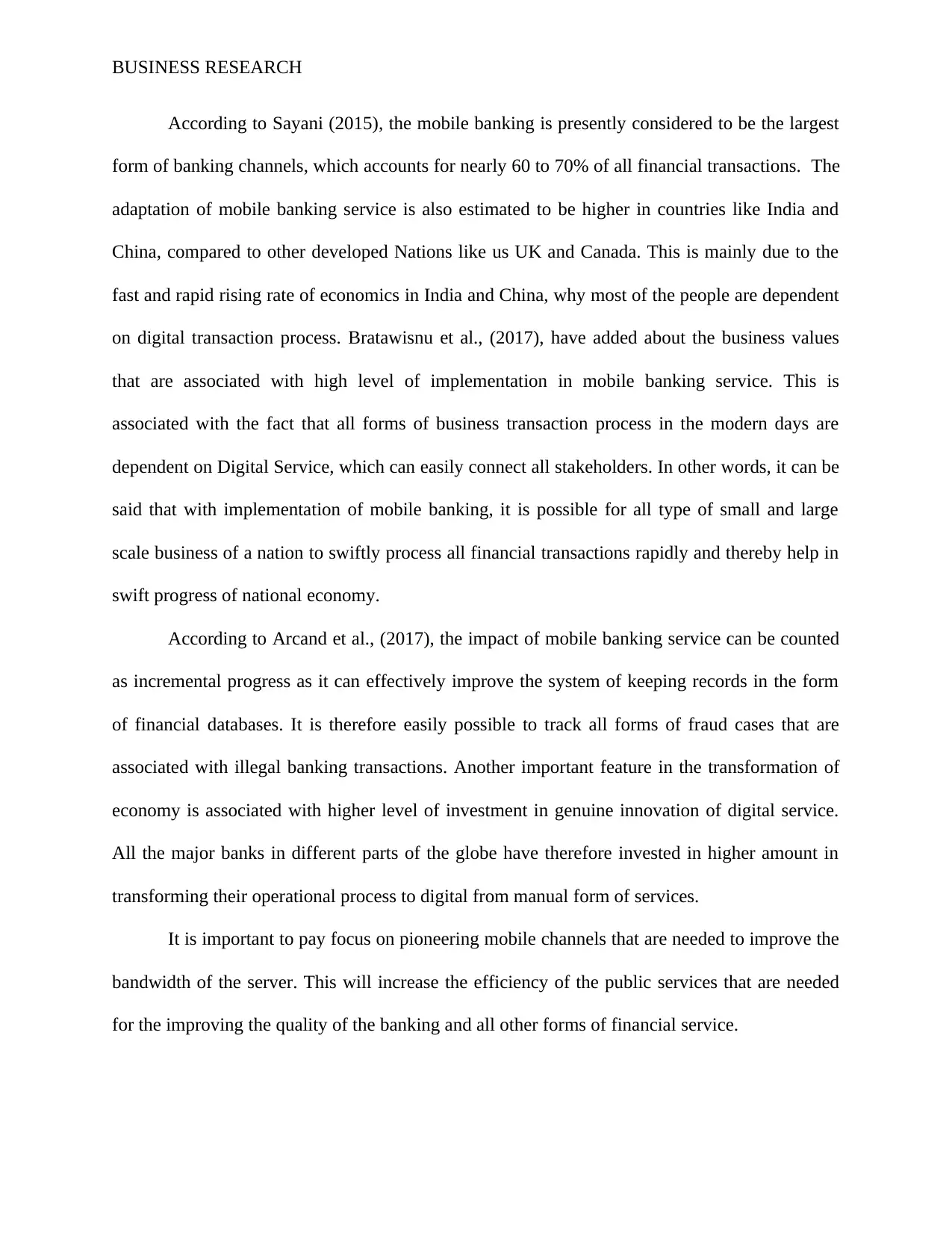
BUSINESS RESEARCH
According to Sayani (2015), the mobile banking is presently considered to be the largest
form of banking channels, which accounts for nearly 60 to 70% of all financial transactions. The
adaptation of mobile banking service is also estimated to be higher in countries like India and
China, compared to other developed Nations like us UK and Canada. This is mainly due to the
fast and rapid rising rate of economics in India and China, why most of the people are dependent
on digital transaction process. Bratawisnu et al., (2017), have added about the business values
that are associated with high level of implementation in mobile banking service. This is
associated with the fact that all forms of business transaction process in the modern days are
dependent on Digital Service, which can easily connect all stakeholders. In other words, it can be
said that with implementation of mobile banking, it is possible for all type of small and large
scale business of a nation to swiftly process all financial transactions rapidly and thereby help in
swift progress of national economy.
According to Arcand et al., (2017), the impact of mobile banking service can be counted
as incremental progress as it can effectively improve the system of keeping records in the form
of financial databases. It is therefore easily possible to track all forms of fraud cases that are
associated with illegal banking transactions. Another important feature in the transformation of
economy is associated with higher level of investment in genuine innovation of digital service.
All the major banks in different parts of the globe have therefore invested in higher amount in
transforming their operational process to digital from manual form of services.
It is important to pay focus on pioneering mobile channels that are needed to improve the
bandwidth of the server. This will increase the efficiency of the public services that are needed
for the improving the quality of the banking and all other forms of financial service.
According to Sayani (2015), the mobile banking is presently considered to be the largest
form of banking channels, which accounts for nearly 60 to 70% of all financial transactions. The
adaptation of mobile banking service is also estimated to be higher in countries like India and
China, compared to other developed Nations like us UK and Canada. This is mainly due to the
fast and rapid rising rate of economics in India and China, why most of the people are dependent
on digital transaction process. Bratawisnu et al., (2017), have added about the business values
that are associated with high level of implementation in mobile banking service. This is
associated with the fact that all forms of business transaction process in the modern days are
dependent on Digital Service, which can easily connect all stakeholders. In other words, it can be
said that with implementation of mobile banking, it is possible for all type of small and large
scale business of a nation to swiftly process all financial transactions rapidly and thereby help in
swift progress of national economy.
According to Arcand et al., (2017), the impact of mobile banking service can be counted
as incremental progress as it can effectively improve the system of keeping records in the form
of financial databases. It is therefore easily possible to track all forms of fraud cases that are
associated with illegal banking transactions. Another important feature in the transformation of
economy is associated with higher level of investment in genuine innovation of digital service.
All the major banks in different parts of the globe have therefore invested in higher amount in
transforming their operational process to digital from manual form of services.
It is important to pay focus on pioneering mobile channels that are needed to improve the
bandwidth of the server. This will increase the efficiency of the public services that are needed
for the improving the quality of the banking and all other forms of financial service.
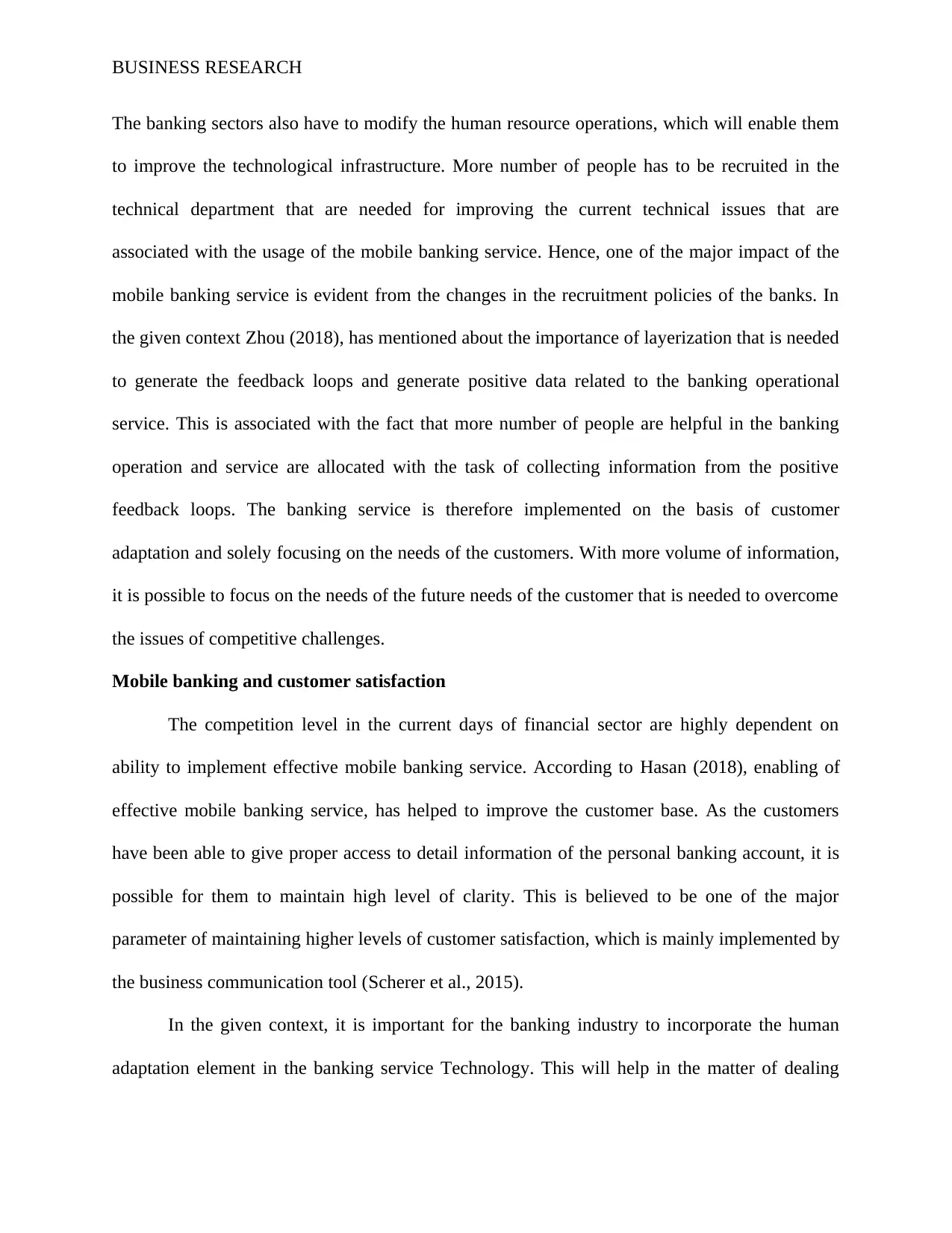
BUSINESS RESEARCH
The banking sectors also have to modify the human resource operations, which will enable them
to improve the technological infrastructure. More number of people has to be recruited in the
technical department that are needed for improving the current technical issues that are
associated with the usage of the mobile banking service. Hence, one of the major impact of the
mobile banking service is evident from the changes in the recruitment policies of the banks. In
the given context Zhou (2018), has mentioned about the importance of layerization that is needed
to generate the feedback loops and generate positive data related to the banking operational
service. This is associated with the fact that more number of people are helpful in the banking
operation and service are allocated with the task of collecting information from the positive
feedback loops. The banking service is therefore implemented on the basis of customer
adaptation and solely focusing on the needs of the customers. With more volume of information,
it is possible to focus on the needs of the future needs of the customer that is needed to overcome
the issues of competitive challenges.
Mobile banking and customer satisfaction
The competition level in the current days of financial sector are highly dependent on
ability to implement effective mobile banking service. According to Hasan (2018), enabling of
effective mobile banking service, has helped to improve the customer base. As the customers
have been able to give proper access to detail information of the personal banking account, it is
possible for them to maintain high level of clarity. This is believed to be one of the major
parameter of maintaining higher levels of customer satisfaction, which is mainly implemented by
the business communication tool (Scherer et al., 2015).
In the given context, it is important for the banking industry to incorporate the human
adaptation element in the banking service Technology. This will help in the matter of dealing
The banking sectors also have to modify the human resource operations, which will enable them
to improve the technological infrastructure. More number of people has to be recruited in the
technical department that are needed for improving the current technical issues that are
associated with the usage of the mobile banking service. Hence, one of the major impact of the
mobile banking service is evident from the changes in the recruitment policies of the banks. In
the given context Zhou (2018), has mentioned about the importance of layerization that is needed
to generate the feedback loops and generate positive data related to the banking operational
service. This is associated with the fact that more number of people are helpful in the banking
operation and service are allocated with the task of collecting information from the positive
feedback loops. The banking service is therefore implemented on the basis of customer
adaptation and solely focusing on the needs of the customers. With more volume of information,
it is possible to focus on the needs of the future needs of the customer that is needed to overcome
the issues of competitive challenges.
Mobile banking and customer satisfaction
The competition level in the current days of financial sector are highly dependent on
ability to implement effective mobile banking service. According to Hasan (2018), enabling of
effective mobile banking service, has helped to improve the customer base. As the customers
have been able to give proper access to detail information of the personal banking account, it is
possible for them to maintain high level of clarity. This is believed to be one of the major
parameter of maintaining higher levels of customer satisfaction, which is mainly implemented by
the business communication tool (Scherer et al., 2015).
In the given context, it is important for the banking industry to incorporate the human
adaptation element in the banking service Technology. This will help in the matter of dealing
⊘ This is a preview!⊘
Do you want full access?
Subscribe today to unlock all pages.

Trusted by 1+ million students worldwide
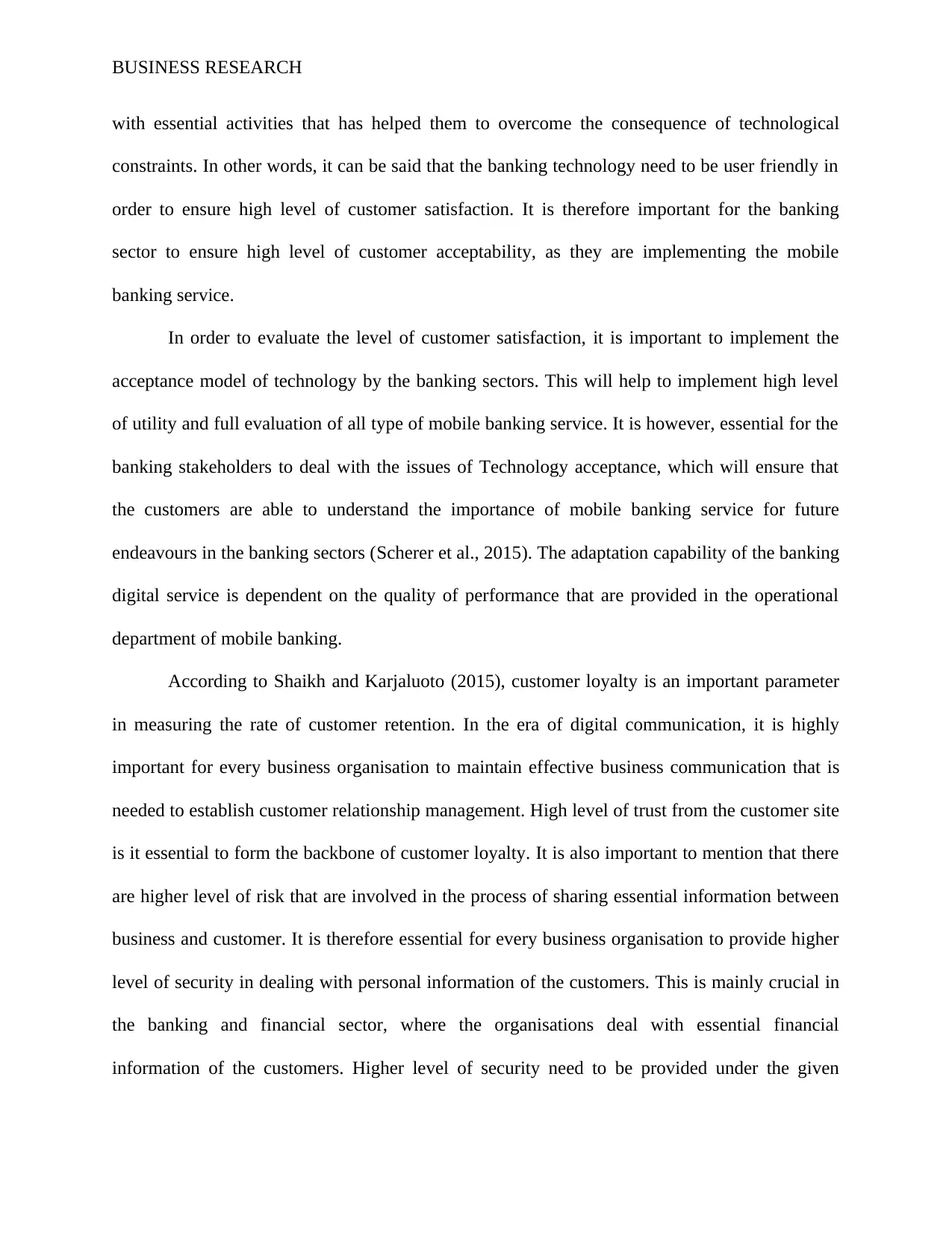
BUSINESS RESEARCH
with essential activities that has helped them to overcome the consequence of technological
constraints. In other words, it can be said that the banking technology need to be user friendly in
order to ensure high level of customer satisfaction. It is therefore important for the banking
sector to ensure high level of customer acceptability, as they are implementing the mobile
banking service.
In order to evaluate the level of customer satisfaction, it is important to implement the
acceptance model of technology by the banking sectors. This will help to implement high level
of utility and full evaluation of all type of mobile banking service. It is however, essential for the
banking stakeholders to deal with the issues of Technology acceptance, which will ensure that
the customers are able to understand the importance of mobile banking service for future
endeavours in the banking sectors (Scherer et al., 2015). The adaptation capability of the banking
digital service is dependent on the quality of performance that are provided in the operational
department of mobile banking.
According to Shaikh and Karjaluoto (2015), customer loyalty is an important parameter
in measuring the rate of customer retention. In the era of digital communication, it is highly
important for every business organisation to maintain effective business communication that is
needed to establish customer relationship management. High level of trust from the customer site
is it essential to form the backbone of customer loyalty. It is also important to mention that there
are higher level of risk that are involved in the process of sharing essential information between
business and customer. It is therefore essential for every business organisation to provide higher
level of security in dealing with personal information of the customers. This is mainly crucial in
the banking and financial sector, where the organisations deal with essential financial
information of the customers. Higher level of security need to be provided under the given
with essential activities that has helped them to overcome the consequence of technological
constraints. In other words, it can be said that the banking technology need to be user friendly in
order to ensure high level of customer satisfaction. It is therefore important for the banking
sector to ensure high level of customer acceptability, as they are implementing the mobile
banking service.
In order to evaluate the level of customer satisfaction, it is important to implement the
acceptance model of technology by the banking sectors. This will help to implement high level
of utility and full evaluation of all type of mobile banking service. It is however, essential for the
banking stakeholders to deal with the issues of Technology acceptance, which will ensure that
the customers are able to understand the importance of mobile banking service for future
endeavours in the banking sectors (Scherer et al., 2015). The adaptation capability of the banking
digital service is dependent on the quality of performance that are provided in the operational
department of mobile banking.
According to Shaikh and Karjaluoto (2015), customer loyalty is an important parameter
in measuring the rate of customer retention. In the era of digital communication, it is highly
important for every business organisation to maintain effective business communication that is
needed to establish customer relationship management. High level of trust from the customer site
is it essential to form the backbone of customer loyalty. It is also important to mention that there
are higher level of risk that are involved in the process of sharing essential information between
business and customer. It is therefore essential for every business organisation to provide higher
level of security in dealing with personal information of the customers. This is mainly crucial in
the banking and financial sector, where the organisations deal with essential financial
information of the customers. Higher level of security need to be provided under the given
Paraphrase This Document
Need a fresh take? Get an instant paraphrase of this document with our AI Paraphraser
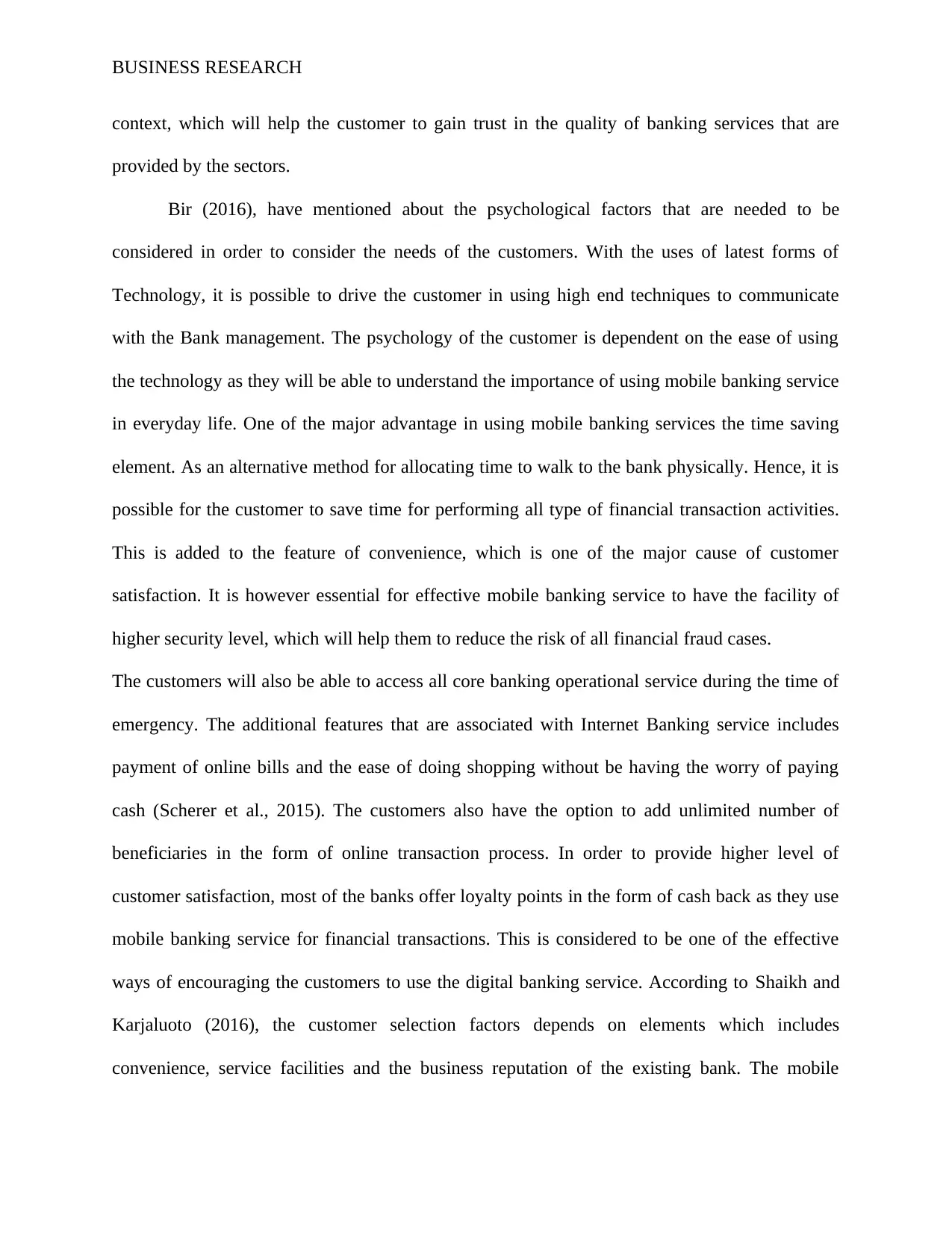
BUSINESS RESEARCH
context, which will help the customer to gain trust in the quality of banking services that are
provided by the sectors.
Bir (2016), have mentioned about the psychological factors that are needed to be
considered in order to consider the needs of the customers. With the uses of latest forms of
Technology, it is possible to drive the customer in using high end techniques to communicate
with the Bank management. The psychology of the customer is dependent on the ease of using
the technology as they will be able to understand the importance of using mobile banking service
in everyday life. One of the major advantage in using mobile banking services the time saving
element. As an alternative method for allocating time to walk to the bank physically. Hence, it is
possible for the customer to save time for performing all type of financial transaction activities.
This is added to the feature of convenience, which is one of the major cause of customer
satisfaction. It is however essential for effective mobile banking service to have the facility of
higher security level, which will help them to reduce the risk of all financial fraud cases.
The customers will also be able to access all core banking operational service during the time of
emergency. The additional features that are associated with Internet Banking service includes
payment of online bills and the ease of doing shopping without be having the worry of paying
cash (Scherer et al., 2015). The customers also have the option to add unlimited number of
beneficiaries in the form of online transaction process. In order to provide higher level of
customer satisfaction, most of the banks offer loyalty points in the form of cash back as they use
mobile banking service for financial transactions. This is considered to be one of the effective
ways of encouraging the customers to use the digital banking service. According to Shaikh and
Karjaluoto (2016), the customer selection factors depends on elements which includes
convenience, service facilities and the business reputation of the existing bank. The mobile
context, which will help the customer to gain trust in the quality of banking services that are
provided by the sectors.
Bir (2016), have mentioned about the psychological factors that are needed to be
considered in order to consider the needs of the customers. With the uses of latest forms of
Technology, it is possible to drive the customer in using high end techniques to communicate
with the Bank management. The psychology of the customer is dependent on the ease of using
the technology as they will be able to understand the importance of using mobile banking service
in everyday life. One of the major advantage in using mobile banking services the time saving
element. As an alternative method for allocating time to walk to the bank physically. Hence, it is
possible for the customer to save time for performing all type of financial transaction activities.
This is added to the feature of convenience, which is one of the major cause of customer
satisfaction. It is however essential for effective mobile banking service to have the facility of
higher security level, which will help them to reduce the risk of all financial fraud cases.
The customers will also be able to access all core banking operational service during the time of
emergency. The additional features that are associated with Internet Banking service includes
payment of online bills and the ease of doing shopping without be having the worry of paying
cash (Scherer et al., 2015). The customers also have the option to add unlimited number of
beneficiaries in the form of online transaction process. In order to provide higher level of
customer satisfaction, most of the banks offer loyalty points in the form of cash back as they use
mobile banking service for financial transactions. This is considered to be one of the effective
ways of encouraging the customers to use the digital banking service. According to Shaikh and
Karjaluoto (2016), the customer selection factors depends on elements which includes
convenience, service facilities and the business reputation of the existing bank. The mobile
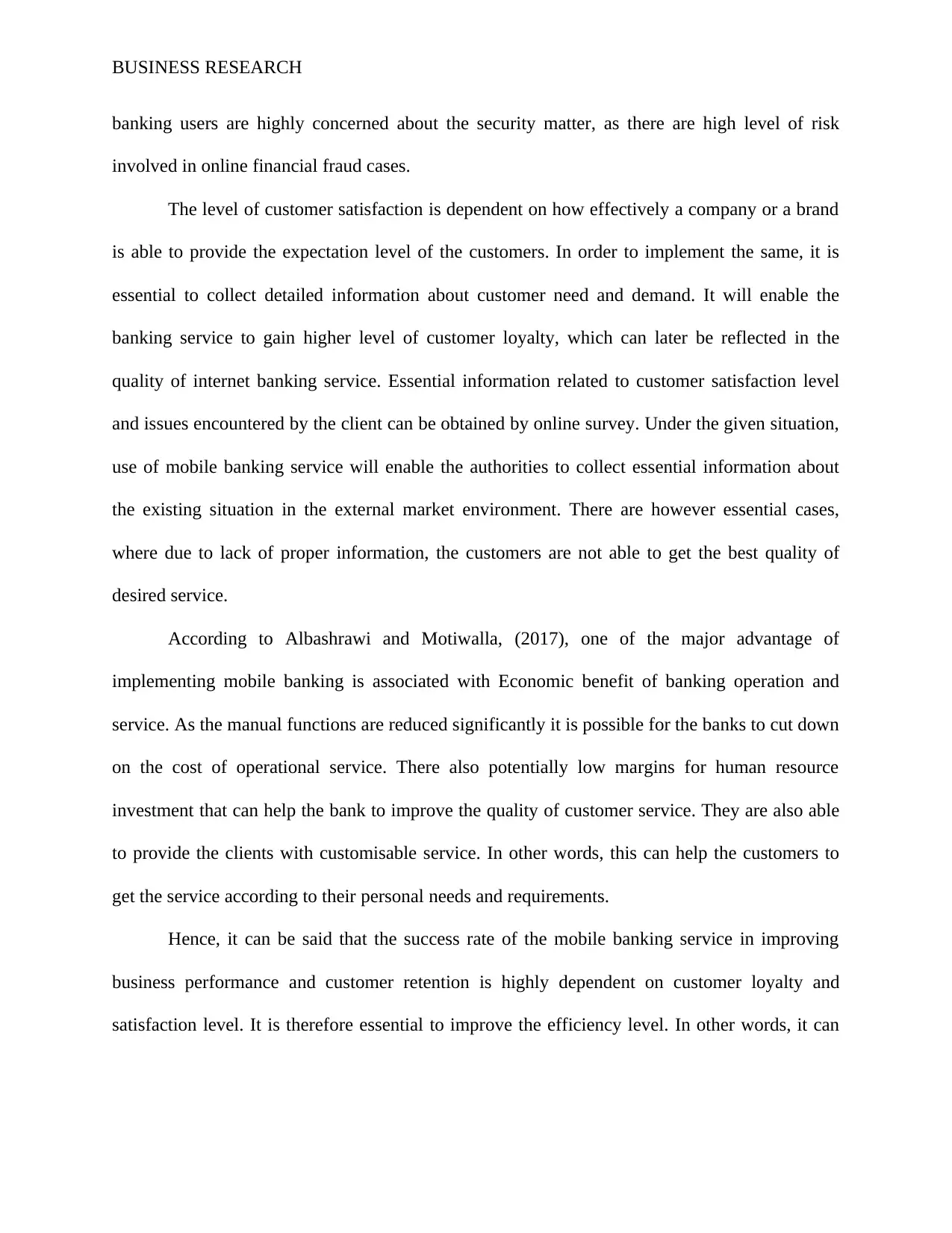
BUSINESS RESEARCH
banking users are highly concerned about the security matter, as there are high level of risk
involved in online financial fraud cases.
The level of customer satisfaction is dependent on how effectively a company or a brand
is able to provide the expectation level of the customers. In order to implement the same, it is
essential to collect detailed information about customer need and demand. It will enable the
banking service to gain higher level of customer loyalty, which can later be reflected in the
quality of internet banking service. Essential information related to customer satisfaction level
and issues encountered by the client can be obtained by online survey. Under the given situation,
use of mobile banking service will enable the authorities to collect essential information about
the existing situation in the external market environment. There are however essential cases,
where due to lack of proper information, the customers are not able to get the best quality of
desired service.
According to Albashrawi and Motiwalla, (2017), one of the major advantage of
implementing mobile banking is associated with Economic benefit of banking operation and
service. As the manual functions are reduced significantly it is possible for the banks to cut down
on the cost of operational service. There also potentially low margins for human resource
investment that can help the bank to improve the quality of customer service. They are also able
to provide the clients with customisable service. In other words, this can help the customers to
get the service according to their personal needs and requirements.
Hence, it can be said that the success rate of the mobile banking service in improving
business performance and customer retention is highly dependent on customer loyalty and
satisfaction level. It is therefore essential to improve the efficiency level. In other words, it can
banking users are highly concerned about the security matter, as there are high level of risk
involved in online financial fraud cases.
The level of customer satisfaction is dependent on how effectively a company or a brand
is able to provide the expectation level of the customers. In order to implement the same, it is
essential to collect detailed information about customer need and demand. It will enable the
banking service to gain higher level of customer loyalty, which can later be reflected in the
quality of internet banking service. Essential information related to customer satisfaction level
and issues encountered by the client can be obtained by online survey. Under the given situation,
use of mobile banking service will enable the authorities to collect essential information about
the existing situation in the external market environment. There are however essential cases,
where due to lack of proper information, the customers are not able to get the best quality of
desired service.
According to Albashrawi and Motiwalla, (2017), one of the major advantage of
implementing mobile banking is associated with Economic benefit of banking operation and
service. As the manual functions are reduced significantly it is possible for the banks to cut down
on the cost of operational service. There also potentially low margins for human resource
investment that can help the bank to improve the quality of customer service. They are also able
to provide the clients with customisable service. In other words, this can help the customers to
get the service according to their personal needs and requirements.
Hence, it can be said that the success rate of the mobile banking service in improving
business performance and customer retention is highly dependent on customer loyalty and
satisfaction level. It is therefore essential to improve the efficiency level. In other words, it can
⊘ This is a preview!⊘
Do you want full access?
Subscribe today to unlock all pages.

Trusted by 1+ million students worldwide
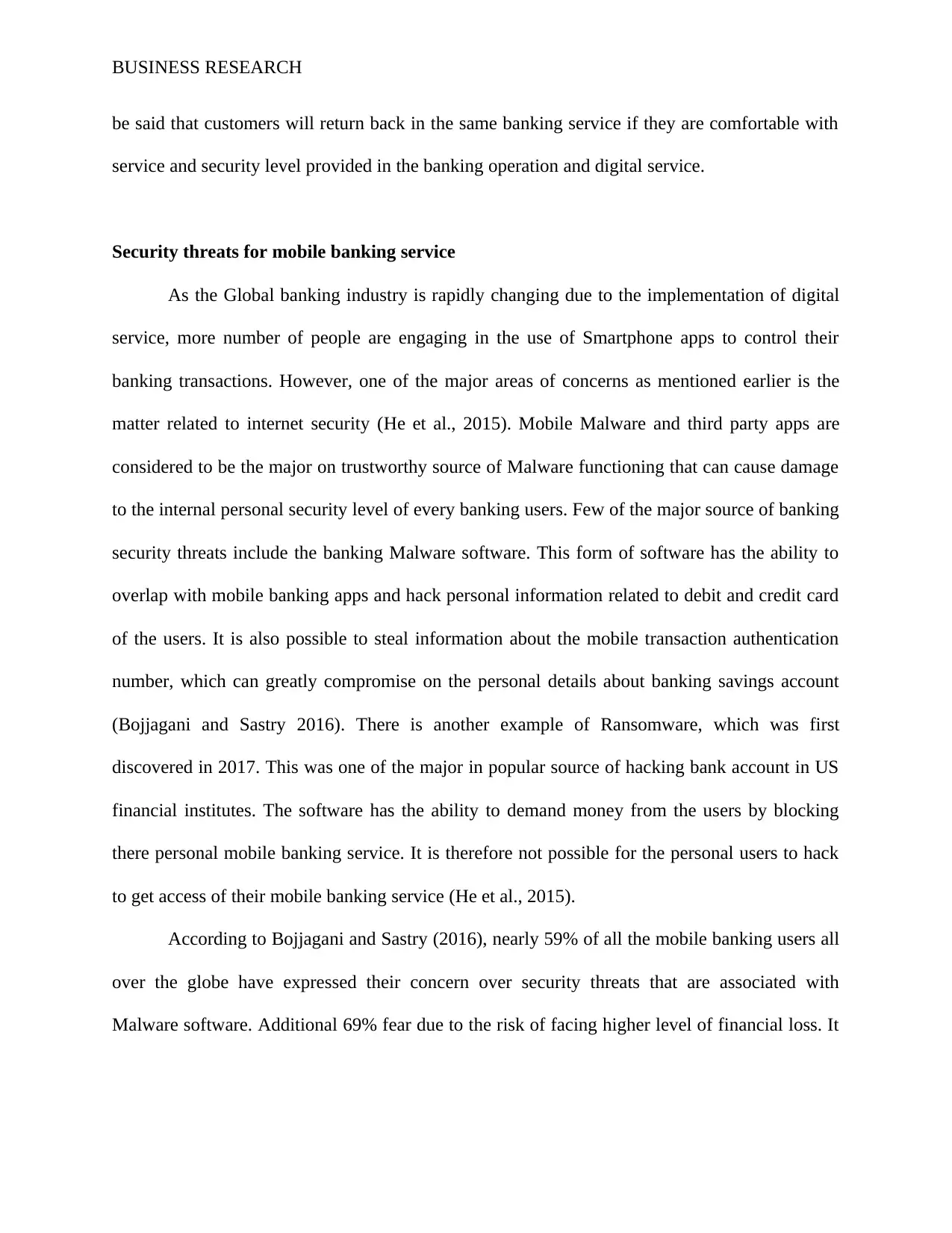
BUSINESS RESEARCH
be said that customers will return back in the same banking service if they are comfortable with
service and security level provided in the banking operation and digital service.
Security threats for mobile banking service
As the Global banking industry is rapidly changing due to the implementation of digital
service, more number of people are engaging in the use of Smartphone apps to control their
banking transactions. However, one of the major areas of concerns as mentioned earlier is the
matter related to internet security (He et al., 2015). Mobile Malware and third party apps are
considered to be the major on trustworthy source of Malware functioning that can cause damage
to the internal personal security level of every banking users. Few of the major source of banking
security threats include the banking Malware software. This form of software has the ability to
overlap with mobile banking apps and hack personal information related to debit and credit card
of the users. It is also possible to steal information about the mobile transaction authentication
number, which can greatly compromise on the personal details about banking savings account
(Bojjagani and Sastry 2016). There is another example of Ransomware, which was first
discovered in 2017. This was one of the major in popular source of hacking bank account in US
financial institutes. The software has the ability to demand money from the users by blocking
there personal mobile banking service. It is therefore not possible for the personal users to hack
to get access of their mobile banking service (He et al., 2015).
According to Bojjagani and Sastry (2016), nearly 59% of all the mobile banking users all
over the globe have expressed their concern over security threats that are associated with
Malware software. Additional 69% fear due to the risk of facing higher level of financial loss. It
be said that customers will return back in the same banking service if they are comfortable with
service and security level provided in the banking operation and digital service.
Security threats for mobile banking service
As the Global banking industry is rapidly changing due to the implementation of digital
service, more number of people are engaging in the use of Smartphone apps to control their
banking transactions. However, one of the major areas of concerns as mentioned earlier is the
matter related to internet security (He et al., 2015). Mobile Malware and third party apps are
considered to be the major on trustworthy source of Malware functioning that can cause damage
to the internal personal security level of every banking users. Few of the major source of banking
security threats include the banking Malware software. This form of software has the ability to
overlap with mobile banking apps and hack personal information related to debit and credit card
of the users. It is also possible to steal information about the mobile transaction authentication
number, which can greatly compromise on the personal details about banking savings account
(Bojjagani and Sastry 2016). There is another example of Ransomware, which was first
discovered in 2017. This was one of the major in popular source of hacking bank account in US
financial institutes. The software has the ability to demand money from the users by blocking
there personal mobile banking service. It is therefore not possible for the personal users to hack
to get access of their mobile banking service (He et al., 2015).
According to Bojjagani and Sastry (2016), nearly 59% of all the mobile banking users all
over the globe have expressed their concern over security threats that are associated with
Malware software. Additional 69% fear due to the risk of facing higher level of financial loss. It
Paraphrase This Document
Need a fresh take? Get an instant paraphrase of this document with our AI Paraphraser
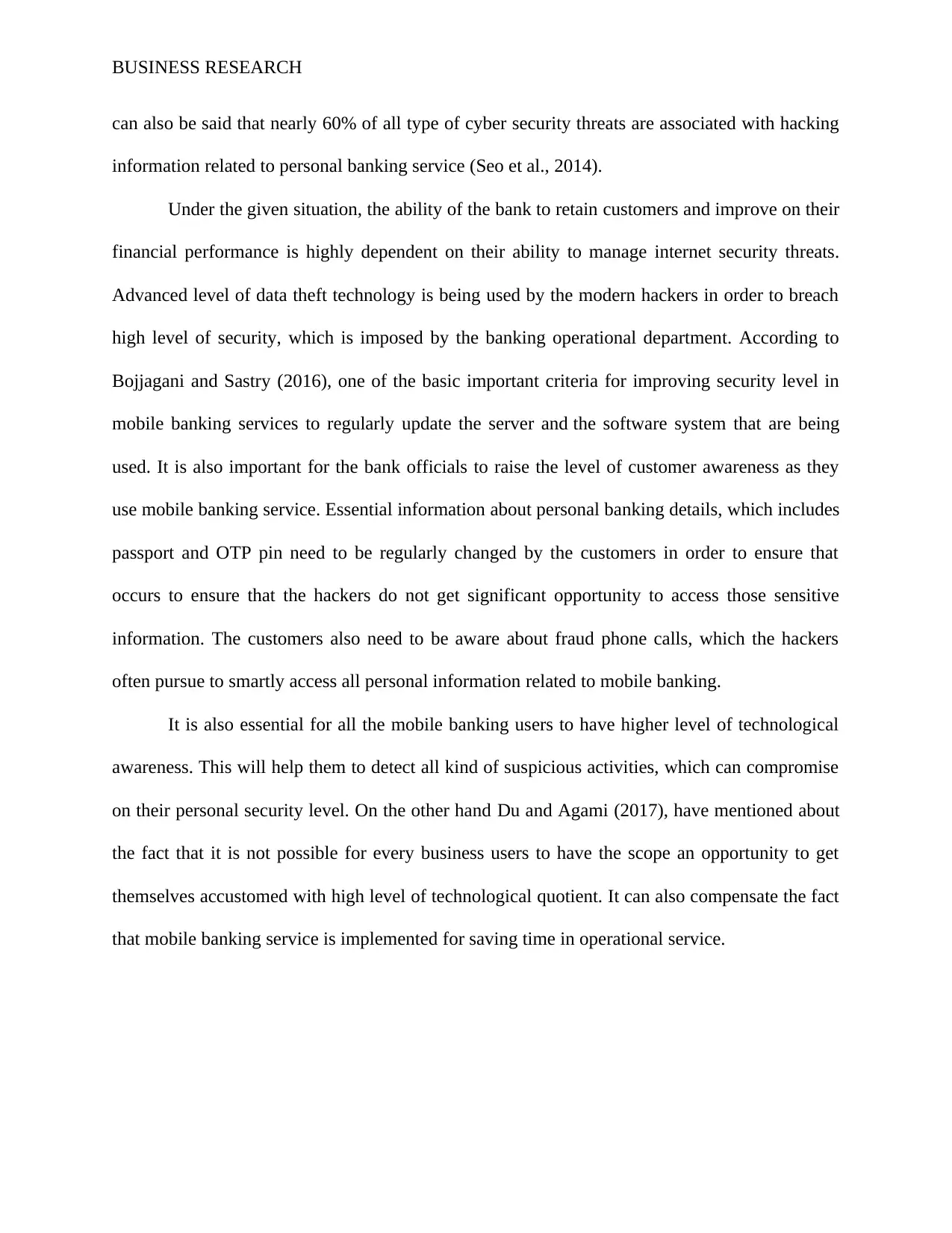
BUSINESS RESEARCH
can also be said that nearly 60% of all type of cyber security threats are associated with hacking
information related to personal banking service (Seo et al., 2014).
Under the given situation, the ability of the bank to retain customers and improve on their
financial performance is highly dependent on their ability to manage internet security threats.
Advanced level of data theft technology is being used by the modern hackers in order to breach
high level of security, which is imposed by the banking operational department. According to
Bojjagani and Sastry (2016), one of the basic important criteria for improving security level in
mobile banking services to regularly update the server and the software system that are being
used. It is also important for the bank officials to raise the level of customer awareness as they
use mobile banking service. Essential information about personal banking details, which includes
passport and OTP pin need to be regularly changed by the customers in order to ensure that
occurs to ensure that the hackers do not get significant opportunity to access those sensitive
information. The customers also need to be aware about fraud phone calls, which the hackers
often pursue to smartly access all personal information related to mobile banking.
It is also essential for all the mobile banking users to have higher level of technological
awareness. This will help them to detect all kind of suspicious activities, which can compromise
on their personal security level. On the other hand Du and Agami (2017), have mentioned about
the fact that it is not possible for every business users to have the scope an opportunity to get
themselves accustomed with high level of technological quotient. It can also compensate the fact
that mobile banking service is implemented for saving time in operational service.
can also be said that nearly 60% of all type of cyber security threats are associated with hacking
information related to personal banking service (Seo et al., 2014).
Under the given situation, the ability of the bank to retain customers and improve on their
financial performance is highly dependent on their ability to manage internet security threats.
Advanced level of data theft technology is being used by the modern hackers in order to breach
high level of security, which is imposed by the banking operational department. According to
Bojjagani and Sastry (2016), one of the basic important criteria for improving security level in
mobile banking services to regularly update the server and the software system that are being
used. It is also important for the bank officials to raise the level of customer awareness as they
use mobile banking service. Essential information about personal banking details, which includes
passport and OTP pin need to be regularly changed by the customers in order to ensure that
occurs to ensure that the hackers do not get significant opportunity to access those sensitive
information. The customers also need to be aware about fraud phone calls, which the hackers
often pursue to smartly access all personal information related to mobile banking.
It is also essential for all the mobile banking users to have higher level of technological
awareness. This will help them to detect all kind of suspicious activities, which can compromise
on their personal security level. On the other hand Du and Agami (2017), have mentioned about
the fact that it is not possible for every business users to have the scope an opportunity to get
themselves accustomed with high level of technological quotient. It can also compensate the fact
that mobile banking service is implemented for saving time in operational service.
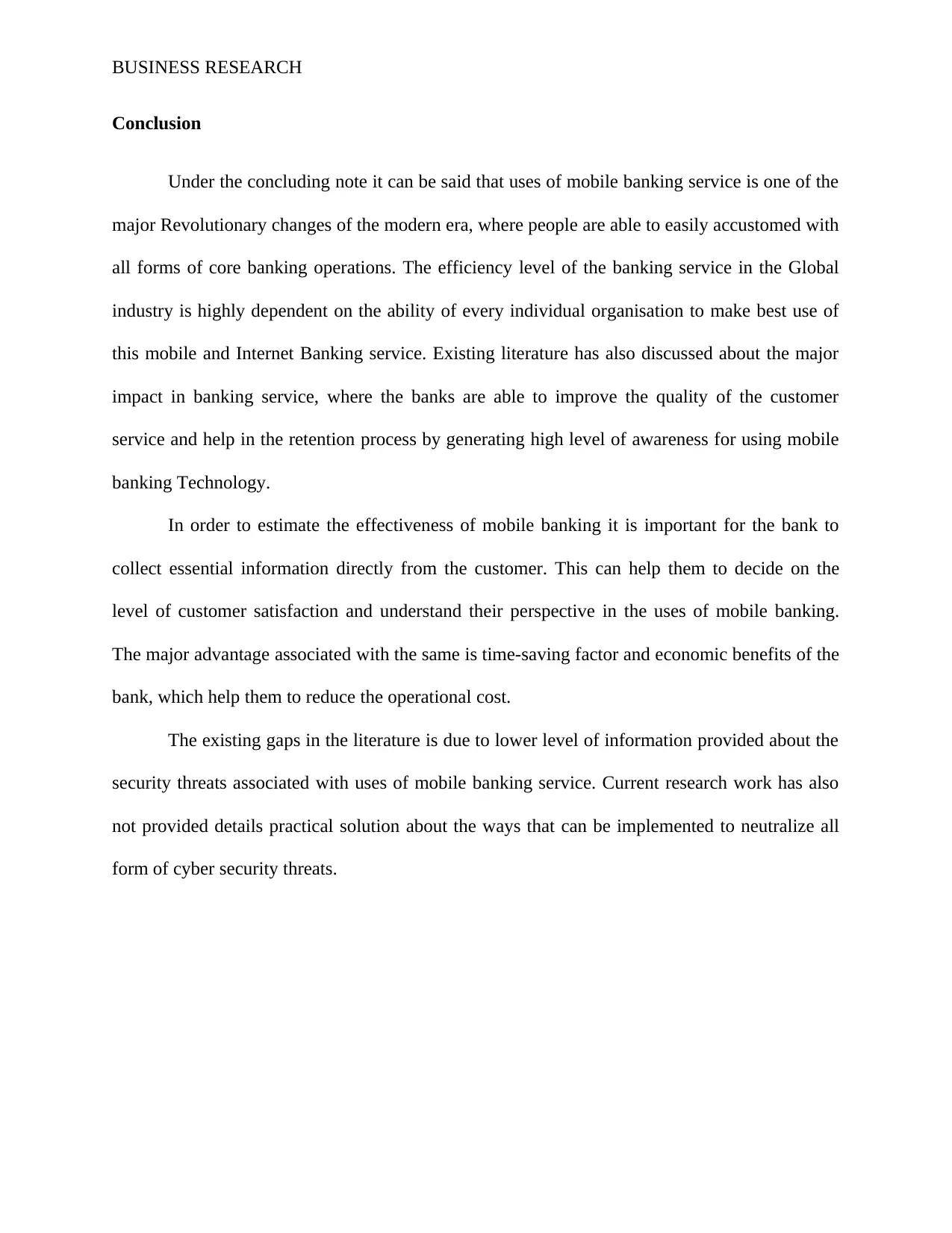
BUSINESS RESEARCH
Conclusion
Under the concluding note it can be said that uses of mobile banking service is one of the
major Revolutionary changes of the modern era, where people are able to easily accustomed with
all forms of core banking operations. The efficiency level of the banking service in the Global
industry is highly dependent on the ability of every individual organisation to make best use of
this mobile and Internet Banking service. Existing literature has also discussed about the major
impact in banking service, where the banks are able to improve the quality of the customer
service and help in the retention process by generating high level of awareness for using mobile
banking Technology.
In order to estimate the effectiveness of mobile banking it is important for the bank to
collect essential information directly from the customer. This can help them to decide on the
level of customer satisfaction and understand their perspective in the uses of mobile banking.
The major advantage associated with the same is time-saving factor and economic benefits of the
bank, which help them to reduce the operational cost.
The existing gaps in the literature is due to lower level of information provided about the
security threats associated with uses of mobile banking service. Current research work has also
not provided details practical solution about the ways that can be implemented to neutralize all
form of cyber security threats.
Conclusion
Under the concluding note it can be said that uses of mobile banking service is one of the
major Revolutionary changes of the modern era, where people are able to easily accustomed with
all forms of core banking operations. The efficiency level of the banking service in the Global
industry is highly dependent on the ability of every individual organisation to make best use of
this mobile and Internet Banking service. Existing literature has also discussed about the major
impact in banking service, where the banks are able to improve the quality of the customer
service and help in the retention process by generating high level of awareness for using mobile
banking Technology.
In order to estimate the effectiveness of mobile banking it is important for the bank to
collect essential information directly from the customer. This can help them to decide on the
level of customer satisfaction and understand their perspective in the uses of mobile banking.
The major advantage associated with the same is time-saving factor and economic benefits of the
bank, which help them to reduce the operational cost.
The existing gaps in the literature is due to lower level of information provided about the
security threats associated with uses of mobile banking service. Current research work has also
not provided details practical solution about the ways that can be implemented to neutralize all
form of cyber security threats.
⊘ This is a preview!⊘
Do you want full access?
Subscribe today to unlock all pages.

Trusted by 1+ million students worldwide
1 out of 17
Related Documents
Your All-in-One AI-Powered Toolkit for Academic Success.
+13062052269
info@desklib.com
Available 24*7 on WhatsApp / Email
![[object Object]](/_next/static/media/star-bottom.7253800d.svg)
Unlock your academic potential
Copyright © 2020–2025 A2Z Services. All Rights Reserved. Developed and managed by ZUCOL.





